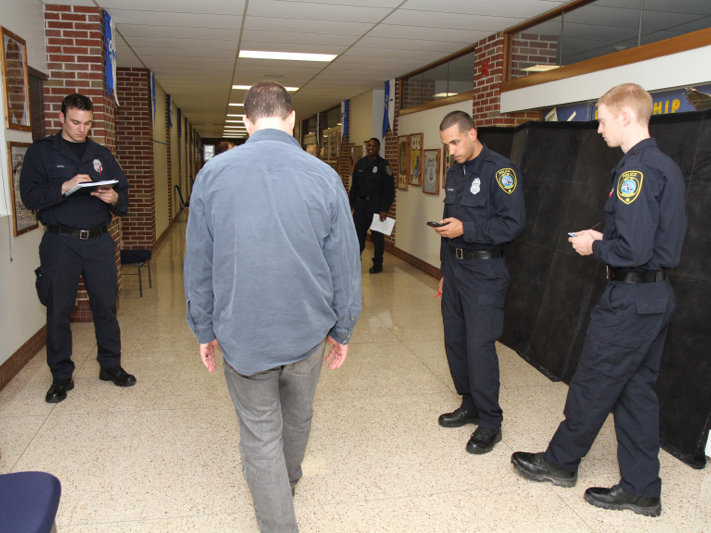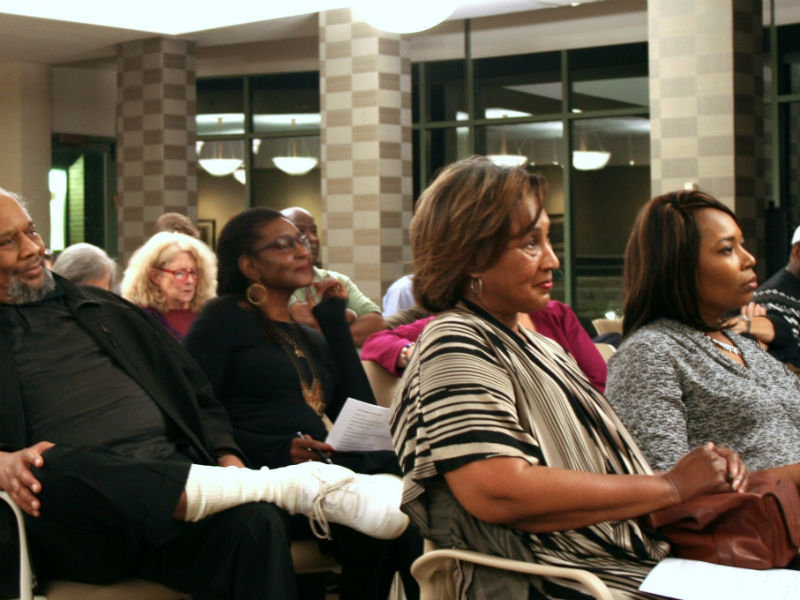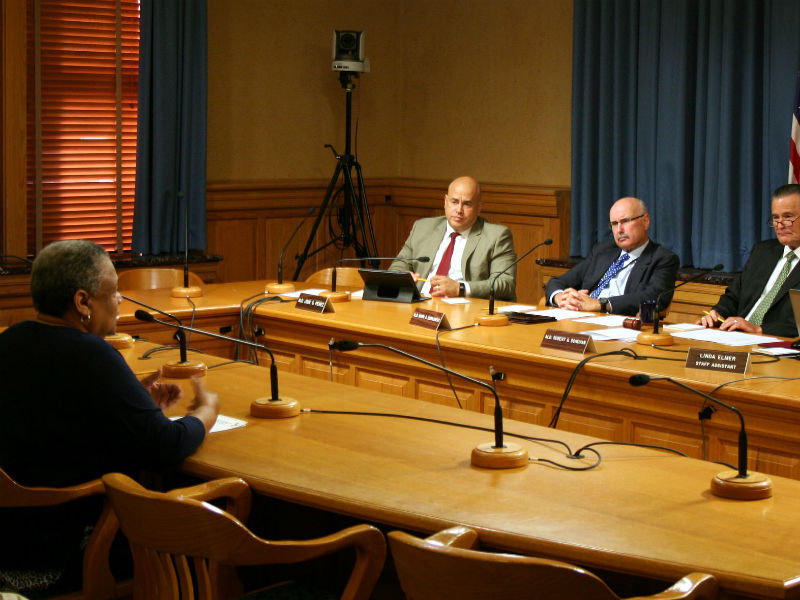My bucket list doesn't include getting drunk in a room full of cops. It also doesn't mention anything about drinking 11 ounces of vodka and nine shots of cheap liquor before 2 p.m. on a Thursday afternoon.
But I just can't pass up a unique opportunity for experiential journalism, and it is the final day of OnMilwaukee.com's Bar Month. I figured I might as well go out with a bang. A .132 percent blood alcohol content sort of bang, actually.
You're welcome, Milwaukee taxpayers.
Before you criticize what seems like – and normally would be – a horrible lack of judgement for a mostly responsible adult, please understand that this wasn't a self-sanctioned or unsupervised midweek bender. Rather, this was a very controlled environment, set up at the Milwaukee Police Academy, designed to train recruits on the identification and testing of potential OWI offenders.
This "wet workshop" is an annual event, three full days of a testing program that occurs about two-thirds of the way through police officer recruits' training. It's sanctioned by the National Transportation Safety Board, so it's standardized from state to state. Participants are usually friends and family of the recruits.
And, in this case, one nervous journalist.
Sgt. John Scheerer, a 10-year veteran of the program, says the event is helpful to the recruits, because it gives them a real-world look at what it's like to test impaired suspects. And, while recruits themselves used to be the subjects, Scheerer enjoys spending the day watching his fellow Milwaukee citizens get drunk, then taking (and usually failing) field sobriety tests.
"I wouldn't do it if I didn't like it," he says.
Also behind the pretend bar set up at the academy is Sgt. Jay Karras. He says his job is to get the group drunk enough that they're not incapacitated but "impaired enough to see the signs that (officers) will see on the street."
Turns out Karras didn't have that hard of a job today.
Our group of eight assembles at 10 a.m. and is ushered into the "bar," which I find pretty amusing. It's been moved and rebuilt this year, and it's decorated with vintage beer signs, a jukebox and old records on the wall.
There's an antique and non-functioning cash register at the bar, with a tip jar next it to, stuffed with fake money. In one corner is a working slot machine. The police have brought bar dice, cribbage boards and just about all you'd need to stock a real bar. But it's bright inside this room, both because it's morning and because all the fluorescent lights are on.
In all, it's probably about the least inviting drinking scenario I've ever been a party to.
At 10:40 a.m., Karras asks us to finish our paperwork and explains the ground rules. First, we are reminded that we need a ride home – my good humored wife dropped me off and would pick me up at 4. I'm already not looking forward to that woozy trip.
Beyond that, basically, we are told to drink as much as we want until about 1:45 p.m. We can drink anything in the well-stocked police bar, except beer. They have about all one could desire, too, from rail to call liquors, and plenty of specialty bottles for shots. We each get cups with our names on them, mostly for record-keeping. By and large, this isn't a heavy drinking group, and the ages range from a few in their 20s to a couple in their 60s.
We're informed that we'll all get breathalyzed before taking the field sobriety tests when they walk us up to the cadets at 2 p.m. As we get started, the young cadets are literally in classrooms at the academy, learning the tests they'll subject us to later.
When we're done, we'll get tested again, and at 4 p.m., we'll be released to our designated drivers. Everyone, cops included, has a good attitude today. I'm probably the most quiet of the group, both because I'm taking notes and because, though I'm a willing participant, I'm not really looking forward to getting drunk.
After what feels like an eternity, Karras asks the participants for our choices. One person requests a gin and tonic. Dave asks for a Long Island iced tea, but when Karras shakes his head, he requests vodka cranberry. Another participant, Tang, brought his own bottle of Grey Goose, so he'll be drinking vodka and Sprite. Laurie requests Bacardi and Diet Coke, while others order Southern Comfort and Sprite, and one person goes for a 7 and 7.
As for me, I order a screwdriver after my request for a Mimosa is laughed off. It's still morning, after all. "Let's light this candle," I say, only half kiddingly. By now, I just want to do this thing.
At 10:50 a.m., as Karras pours our drinks into red plastic cups, we're given our final instructions: Don't try to trick the recruits. Don't try to get hammered. Do eat the pizza and snacks. No wandering the halls, and we'll need an instructor if we want to to leave the room for a bathroom break. "Keep it quiet in the hall; in here, you can be loud."
I ask one of the officers how drunk he'd like us to get. "We're trying to get you between .08 and .1 percent," he says.
I'll do my best.
At 11 a.m., I "enjoy" my first drink, a rather stiff screwdriver, and it calms my jangled nerves. At first, the cops are pouring two ounces of liquor in every cocktail, so these are technically "doubles." I take a peek behind the bar and see that my vodka is the less-than-high-end Skol. Tang was wise to bring his own booze in.
This group becomes friendly very quickly. Some are playing cribbage while the radio plays Spin Doctors, then thankfully gets switched to oldies. I suck my drink down fast. At 11:14 a.m. I request my second drink. I'm suddenly not nervous anymore.
Speaking of shots, at 11:25, the group is doing them. Mostly Apple Pucker.
At 11:40 a.m., we're doing another round of shots. I'm all in.
At 11:50, I order my third screwdriver. I amuse some of us by saying, "Officer, may I have another drink?" I amuse only myself at noon when we do two consecutive shots and I offer a toast to former Police Chief Arthur Jones.
Group-wide, any social inhibitions at this point are gone. While I'm quietly and tipsily going about my business, others are dancing and singing, and Dave is doing magic tricks. Someone is talking about spankings. Some are doing pushups. This group is definitely drunk, and I'm getting chatty. I ask Karras who he thinks is the most intoxicated in the group. We both think it's Dave, slurring his speech, drinking the vodka cranberries.
At 12:25 p.m., someone (probably Laurie) convinces us to do a shot of Jaegermeister. Ugh. Finally, it's time for much-needed pizza, and the group quiets down.
According to the records, I had two or three more drinks, the last with just one ounce of vodka. Honestly, it's a bit blurry, though I feel very much in control – but clearly impaired.
At 2 p.m., this part of the experiment is complete. Like kindergarteners, we all walk to the restrooms, then we line up to be breathalyzed, something I've never done and hope never to do again. I predict I'll blow a .15 percent. I was fairly close; at the end, they revealed our actual numbers.
Over the next hour and a half, we undergo what I imagine would normally be a terrifying experience: taking multiple field sobriety tests, as groups of recruits move from one participant to another. At the end, I think about five teams of recruits test me, but I'm expending more mental energy trying to pass the tests than count how many times I walked the line.
Apparently, all but one of us would've been arrested had this been real life. Dave doesn't make it past one test; he is quickly ushered away, since he can't stand (and later throws up twice). The guy to my left is falling all over the cops. Teng is counting very loudly in Hmong.
Interestingly, I feel like I did a reasonably OK job on the two physical tests. They included walking nine steps, one foot in front of the other, and standing on one leg for about 20 seconds. The test that even the most composed drunk, however, cannot beat is the Horizontal Gaze Nystagamus Test, or HGN.
According to the training officers, a drunk person's eyes will wiggle at the peripheries when impaired. I see our final results, and all of us (but Jerry) scored from four to six (the worst score) on this test. I score 6, 6, 6, 6, 6, 6, 5 and 4.
On the "Walk and Turn Test," my scores are 2, 0, 3, 5, 2, 4, 5 and 4, as each of the cadets reported. On the "One Leg Standing Test," my scores are 3, 1, 0, 4, 1, 2, 2 and 3.
Now, there's ample evidence on the Web on what all these scores mean, exactly, but my take-away was fairly simple: even though I felt coherent and kind of composed, I failed by enough to warrant being arrested, at which point, if this were in real life, I would take an official breathalyzer test.
As officers explained, they're looking for signs beyond balance; like listening to instructions, starting and stopping, slurring, etc. All they're doing at this point is getting enough proof to take a suspect in.
Bottom line, good luck trying to fool a cop if you're pulled over when drunk.
At 3:25 p.m., we're finally finished, and the officers bring us back to the room, and we're breathalyzed one more time. Jerry has the lowest BAC at .028 percent. He consumed 10 ounces of booze, but it was all Malibu, which the officers explain is very weak. My BAC actually goes up from .129 to .132 percent. Laurie is the highest, peaking at .180 percent, but she admits that she was drinking the night before and came in with a buzz.
The officers ask us before the field sobriety tests if we think we could drive, and our answers are split (I say yes, but only a very short distance). After the test, they ask us again, and I still say yes, but only like down the street. Scores aside, I feel much more pulled together than I expected during the test, and my normally mediocre balance is better than I thought it would be six months after back surgery.
But during that awkward ride home at 4 p.m., as I recline the seat and my wife talks to me about her day, life gets foggy and I realize there was no way I would try driving ... anywhere. I am not wasted, really. But I am plenty, completely and legally drunk.
The rest of the day is a mess. I climb straight into a bed for a two-hour nap, wake up at 6 p.m. hungover and parched, then I half-heartedly watch a little TV before tossing and turning all night. I'm too old for a day-drinking bender.
However, my day is also fascinating, because rarely do we have the opportunity to scientifically measure our alcohol intake, to see what is and what isn't legally drunk. Yes, I pounded a very unrealistically high quantity of booze during this three-hour period – but there's no way I would consume this much, this quickly, on an average night out.
Still, had I skipped the Jaegermeister, or declined that fourth or fifth cocktail, I might've squeaked under the legal limit. Maybe.
In other words, perhaps one can drink more (or less) than expected and blow a .08. Yet, it's a huge gamble and the results can be devastating.
I hope my humbling experience and wasted day – literally and figuratively – helped these cadets get the experience they need to be better Milwaukee cops. For me, it was a good reminder that no matter how balanced, no matter your tolerance, no matter how cool you think you are, you're playing Russian Roulette if you drink and drive. For me, it's easier, safer and way smarter to just call a cab.
Andy is the president, publisher and founder of OnMilwaukee. He returned to Milwaukee in 1996 after living on the East Coast for nine years, where he wrote for The Dallas Morning News Washington Bureau and worked in the White House Office of Communications. He was also Associate Editor of The GW Hatchet, his college newspaper at The George Washington University.
Before launching OnMilwaukee.com in 1998 at age 23, he worked in public relations for two Milwaukee firms, most of the time daydreaming about starting his own publication.
Hobbies include running when he finds the time, fixing the rust on his '75 MGB, mowing the lawn at his cottage in the Northwoods, and making an annual pilgrimage to Phoenix for Brewers Spring Training.







